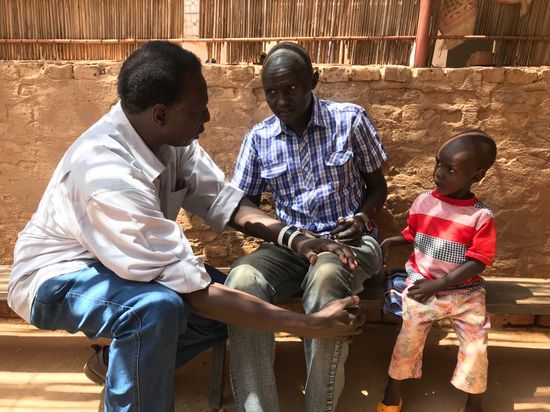
Leprosy is one of the oldest diseases known to mankind. Despite considerable progress since the introduction of multidrug therapy (MDT) in 1982, new cases of leprosy continue to be detected. Around 200,000 new cases are reported annually by more than 100 countries. The disease affects primarily the skin and peripheral nerves. Early diagnosis and prompt treatment ensures complete cure and prevention of disabilities.
Leprosy is one among the three diseases, targeted for interruption of transmission in the WHO NTD roadmap 2021-2030. The Global Leprosy Strategy 2021-2030, a constituent of the NTD roadmap, calls for accelerating action to reach the goal of zero leprosy. The new Leprosy Elimination Framework provides a clear pathway for national programmes through three phases, i.e., interruption of transmission, elimination of leprosy disease and post-elimination surveillance.
This course addresses the epidemiological, clinical, and public health aspects relevant to the disease.
Photo credit: Stephanie Roberts - The Leprosy Mission International
Language: English
Leprosy
Course information
This course is also available in the following languages:
Overview: Leprosy can be diagnosed and treated effectively at the peripheral healthcare level. The aim of the course is to increase the knowledge and skills of front-line healthcare workers to be able to provide the essential services to persons affected by the disease.
The course aims to provide information about leprosy to increase the knowledge and skills of front-line health workers in national programmes to manage this disease and its complications.
Learning objectives: By the end of this course, you will:
- Describe the epidemiology of leprosy
- Identify suspected cases and provide referral
- Describe the cardinal signs for diagnosing leprosy
- Treat using appropriate treatment regimens
- Identify and manage lepra reactions
- Manage disabilities related to hands, feet, and eyes, including through self-care
- Explain public health interventions to reduce the magnitude of the disease, including post-exposure prophylaxis
Course duration: Approximately two hours.
Certificates: A Record of Achievement certificate will be available to participants who score at least 80% in the final assessment. Participants who receive a Record of Achievement can also download an Open Badge for this course. Click here to learn how.
Course contents
Module 1: Introduction:
This introductory module gives an overview of leprosy and the basic epidemiology of the disease. By the end of this module, you will describe how leprosy is transmitted; the age and gender distribution of cases; the geographical distribution of leprosy; disabilities, and stigma associated with leprosy.Module 2: Suspect and refer:
By the end of this module, you will explain when to suspect leprosy; differentiate between leprosy and non-leprosy skin patches; and explain the action to be taken when a person presents with lesions suggestive of leprosy.Module 3: Diagnosis and treatment:
By the end of this module, you will describe the cardinal signs of leprosy and the importance of early diagnosis; classify leprosy into types – paucibacillary and multibacillary; and describe treatment regimens.Module 4: Nerve Function Assessment (NFA):
By the end of this module, you describe the importance of nerve function assessment in leprosy; sensory and voluntary muscle testing of peripheral nerves; WHO grading of disability for leprosy.Module 5: Lepra reactions :
By the end of this module, you should be able to: explain lepra reactions and neuritis; describe the signs and symptoms of Type 1 and Type 2 lepra reactions, as well as explain the management of lepra reactions.Module 6: Prevention and management of disabilities due to leprosy :
By the end of this module, you will describe the consequences of nerve damage in hands, feet and eyes; mechanisms of impairments of hands, feet and eyes due to nerve damage; and consequences of nerve damage due to leprosy.Module 7: Self-care of disabilities:
By the end of this module, you will: identify basic principles and practices of self-care, describe the activities to be carried out to limit disabilities through self-care, demonstrate self-care habits to patients, explain how to monitor the “self-care” activities, describe the principles in formation of a “self-care” group.Module 8: Laboratory diagnosis- Slit Skin Smear:
By the end of this module, you will describe the importance of slit skin smear (SSS) in diagnosing and classifying leprosy, and in the follow-up of treatment with MDT, identify the technique of taking, staining, reading the SSS and documenting the results.Module 9: Post Exposure Prophylaxis (PEP):
By the end of this module, you will be able to describe the importance of contact tracing and post exposure prophylaxis with single dose of rifampicin (SDR).Module 10: Public health interventions:
By the end of this module, you will explain key public health interventions to reduce the magnitude of disease.Module 11: WHO Technical guidance on interruption of transmission and elimination of leprosy disease :
By the end of this module, you will explain: Key concepts and definitions related to elimination of leprosy disease; Global Leprosy Strategy 2021-2030; Leprosy Elimination Framework; Leprosy Elimination Monitoring Tool (LEMT) and Leprosy Programme and Transmission Assessment tool (LPTA).Final Assessment
Enroll me for this course
Certificate Requirements
- Gain a Record of Achievement by earning at least 80% of the maximum number of points from all graded assignments.
- Gain an Open Badge by completing the course.